CHAPTER 4
THE MOTIVE POWER DEPOT
AND ENGINEERING WORKS
A description of Brighton Motive Power Depot (hereafter MPD) published in 1913 gave the dimensions of then main shed as 158 feet long and 201 feet wide, with 14 roads inside. Between this building and the running lines, there was a separate shed 483 feet long and 50 feet wide with 3 roads. This was equipped, at the time, as a washing shed, but in the 1920’s it was known as the New Shed and used for preparing locomotives for their duties.
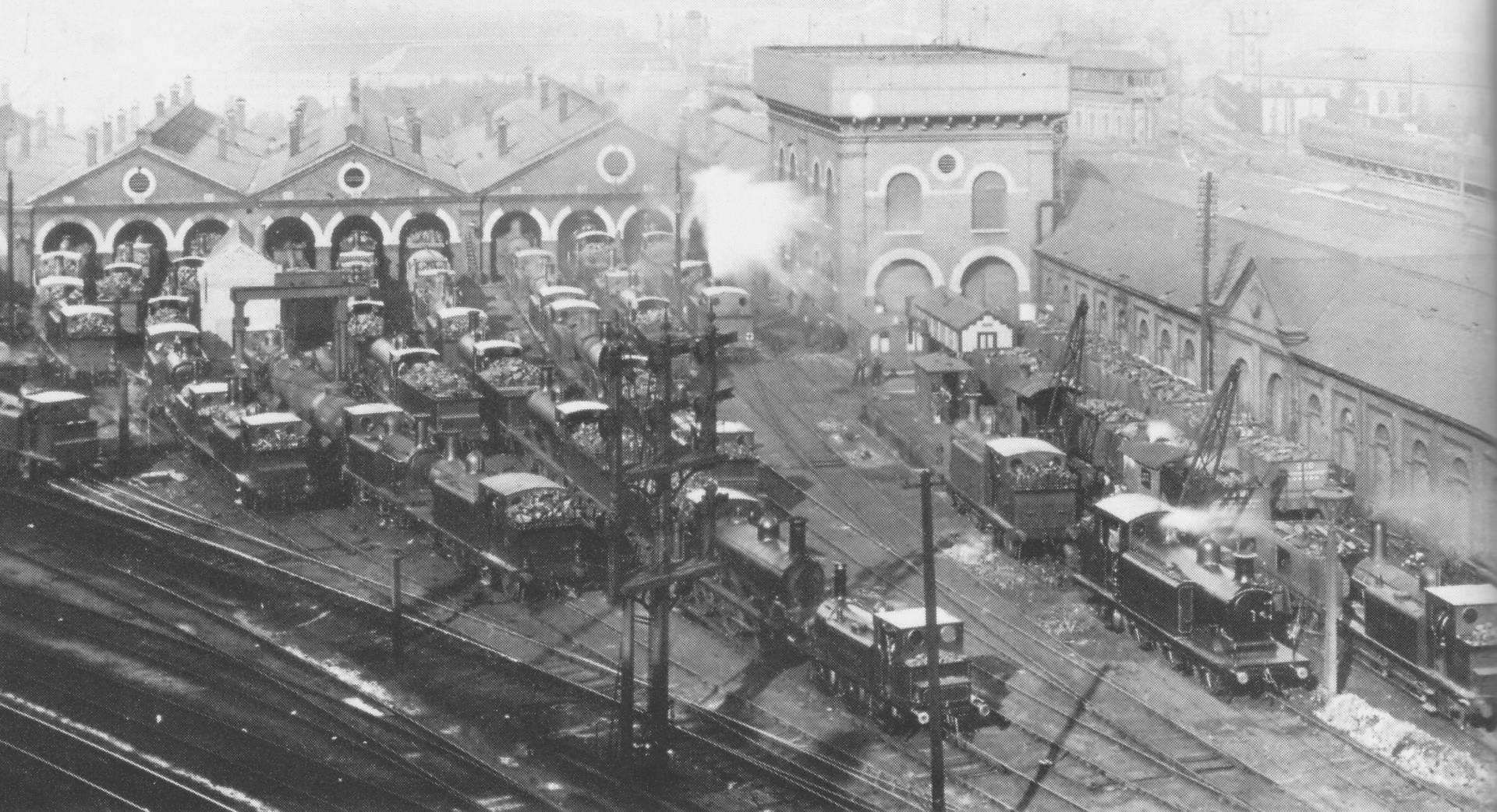
ABOVE: This picture shows the main shed and the New Shed, in the triangle bound by the West Coast Line, The London Main Line & New England Street. The West Coast Line sweeps round towards Hove at the bottom left corner. The Montpelier Signal Box can just about been seen to the top right of the water tower. Note the 2 steam cranes used for coaling the trains.
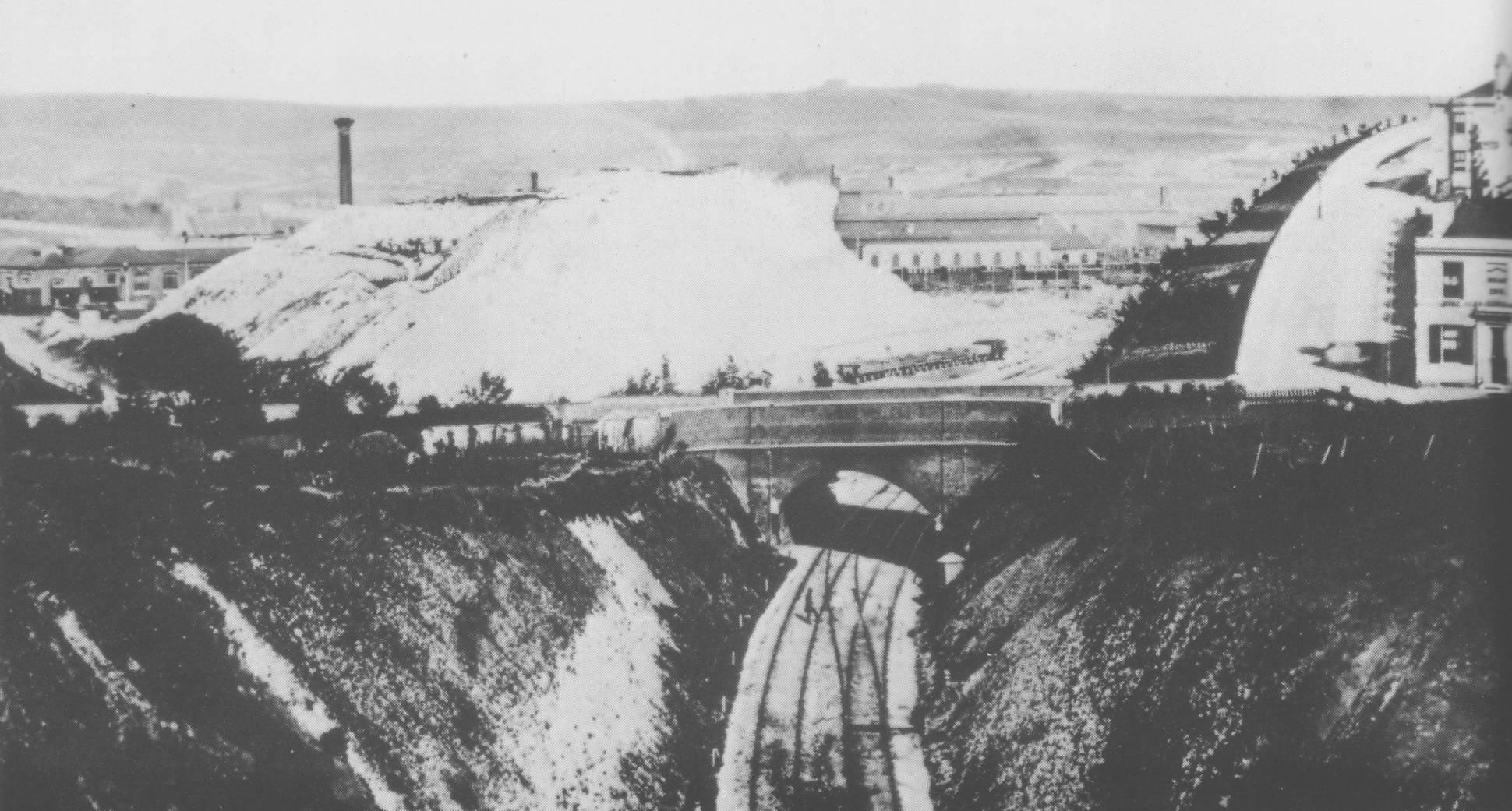
ABOVE & BELOW: These 2 pictures show the site of the ‘New Shed’. The huge chalk pile was gradually removed to make the New Shed and carriage sheds in 1861-1863. Originally the MPD was on the site of The Works. The Main Line loco shed (the original loco shed) and the loco works can be seen centre right, next to the chalk hill. The view below is taken 75 years later. Note how Brighton had expanded in 75 years; the hills around the valley are just open farmland in the top view. Photos owned by the Madgewick Collection & Ian Allen Publishing.
A present day of the same location is seen, in colour, immediately after, taken on the same spot in 2020. Photo from Author's Collection.
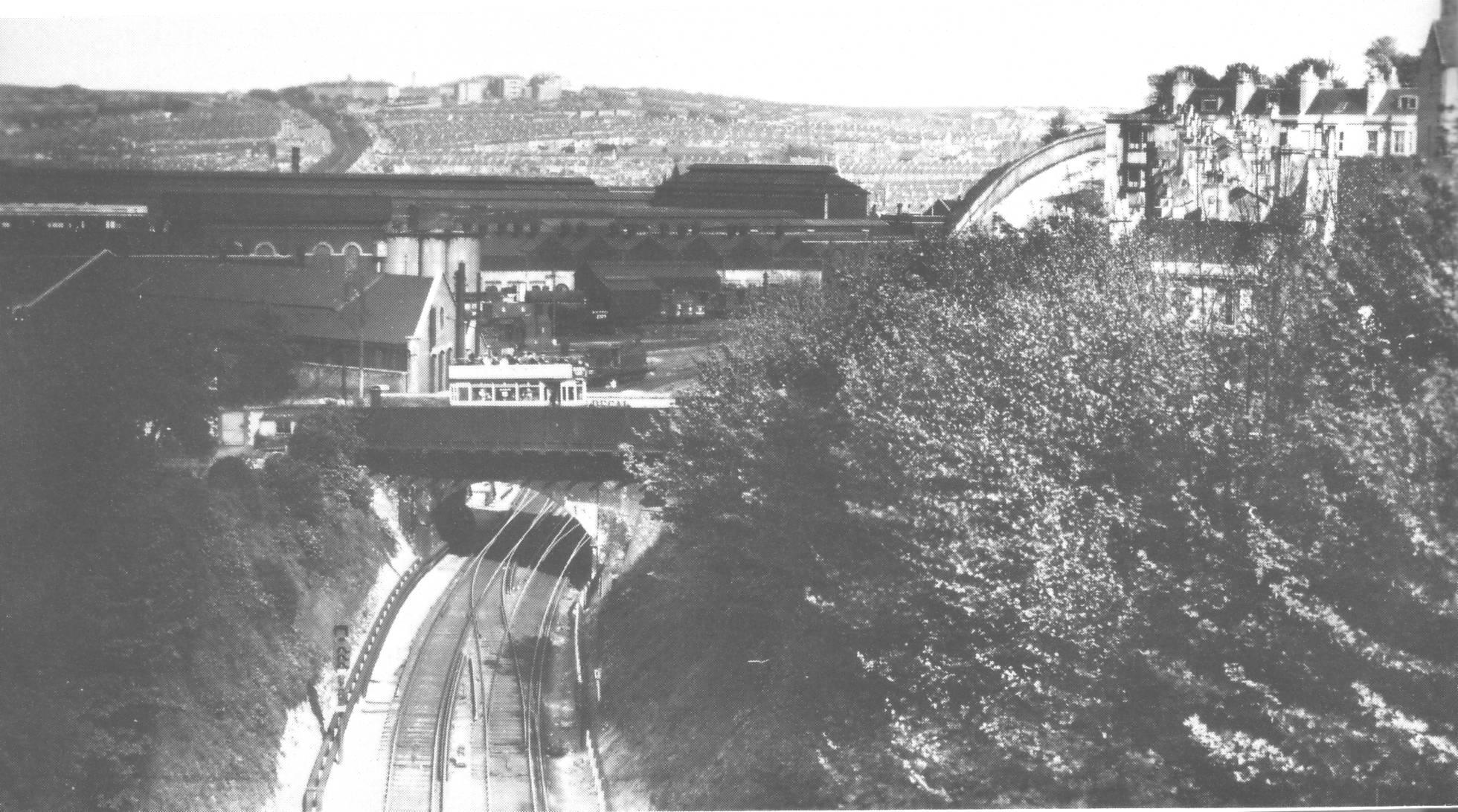
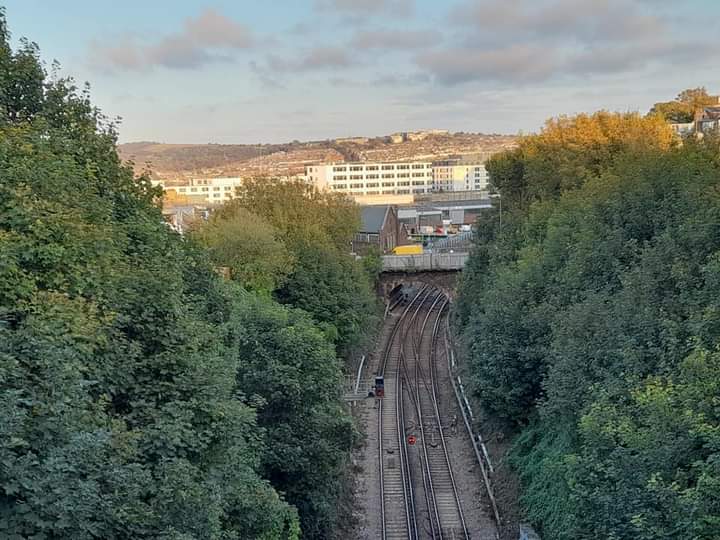
The roads entered the shed at the station end and emerged at the country end, continuing to connect with the main lines into the station. Locomotives that were ready for service were parked on these tracks until the time came for them to be connected to their trains. They were arranged on these tracks in order of their departure and were despatched one after the other to run forward over the points and then back onto their coaches in the main line platforms.

ABOVE: The New Shed siding seen here were originally used as a washing shed, which explains the proximity of the water tower and the water treatment plant, which would otherwise be poorly sited, having virtually no access for service. The 1932 signal box can be seen in the right corner, perched on a wall at the northernmost end of the Engineering Works.

The MPD (above) shown in 1960. The large building at the top of the picture still remains today as a carriage shed. The roof of the MPD (foreground) was originally pitched in the opposite direction and access was gained through 10 arches, one of which still exists on the left of the frontage.
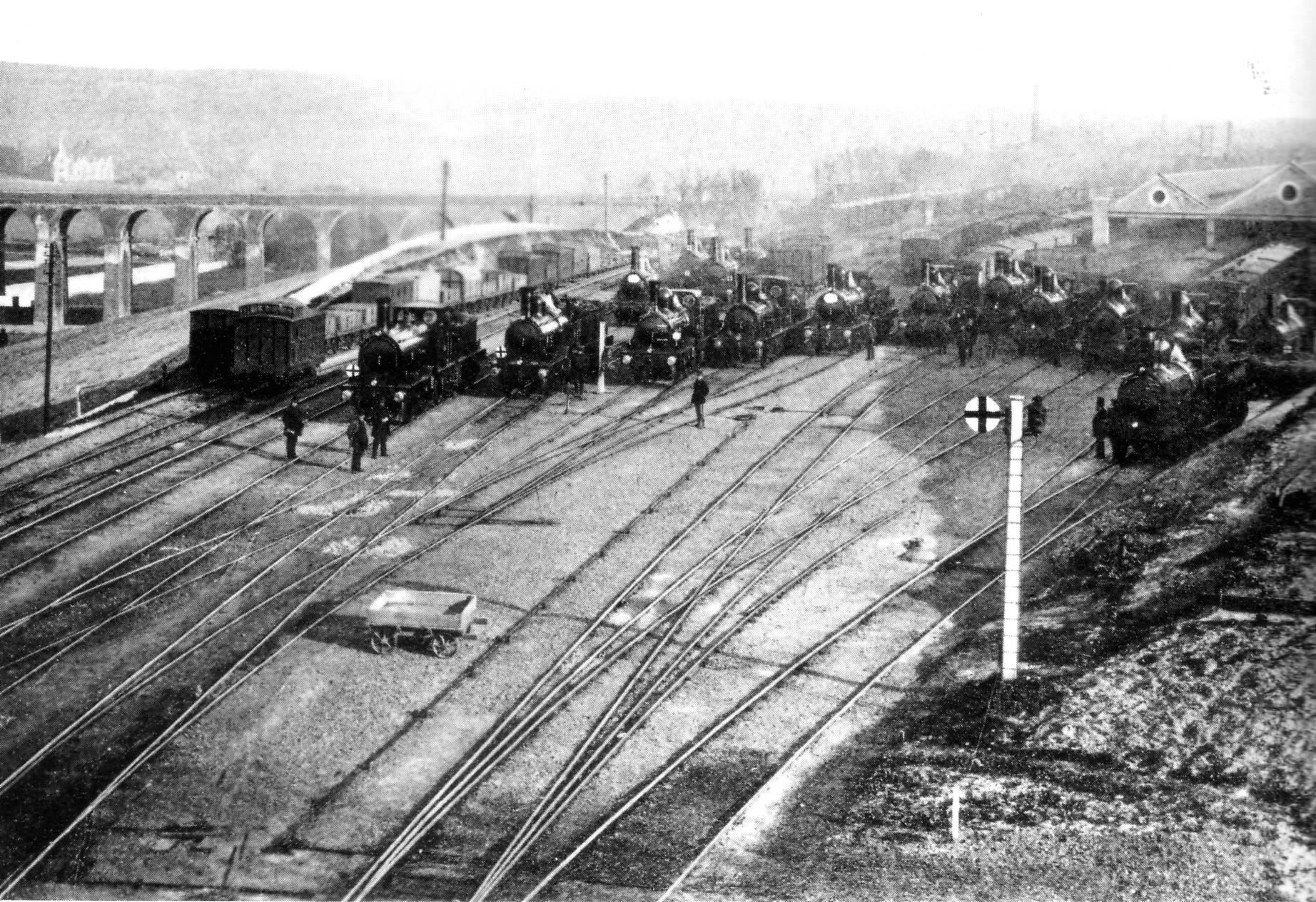
ABOVE: An early view of the rear of the main shed, with locos waiting to be backed onto their trains. Note the whit building in the top left hand corner of the photo: Originally a college, this handsome building still stands in the present day and is a film and media production training centre. The chalk bank beyond the row of trucks on the left will one day be removed for the construction of sidings and the track leading to the Lower Goods Yard. Preston Road and Dyke Road Drive (which runs down the hill far left in the present day) have yet to be constructed and the hills on the left are blissfully free of the houses we know in the present day. Photo owned by the Madgewick Collection.
The main shed had no outlet at the country end and locos proceeding to there to their duties, had to back into the station first, before shunting onto their trains. Locos needing to be turned did not have to enter the yard, as there was also a turntable between the Main and East Coast lines at Montpelier Junction.
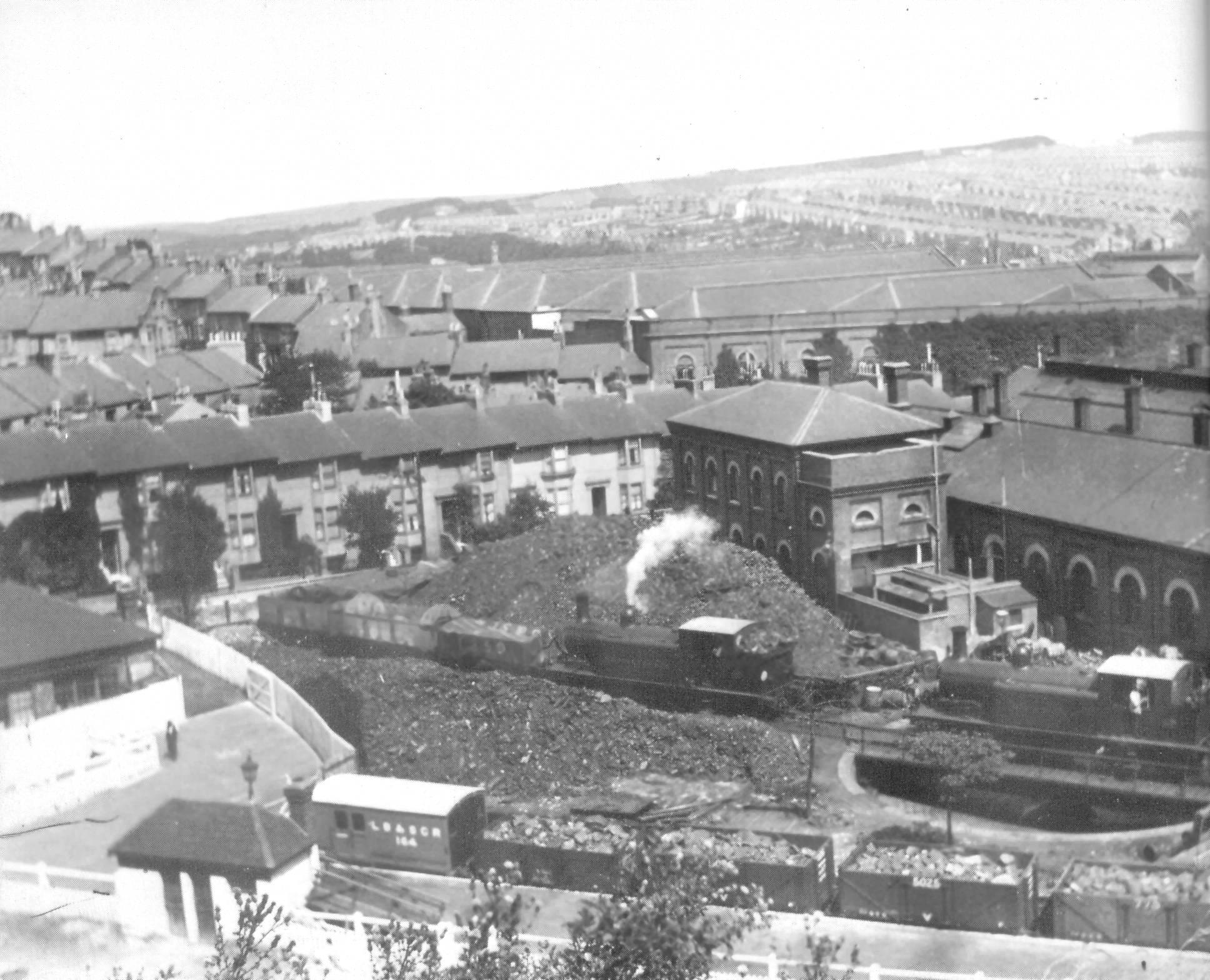
ABOVE: Overlooking the West Coast Line we can see the side of the MPD and part of the coal store and turntable. Note the frontage of the houses in New England Street: their view has changed completely as a new combined engineering building now occupies this spot.
The New Shed was abandoned after electrification and in its final years was used for motor vehicle maintenance, foreshadowing one of the functions of the engineering departments’ establishment, which later occupied the whole of the MPD site.
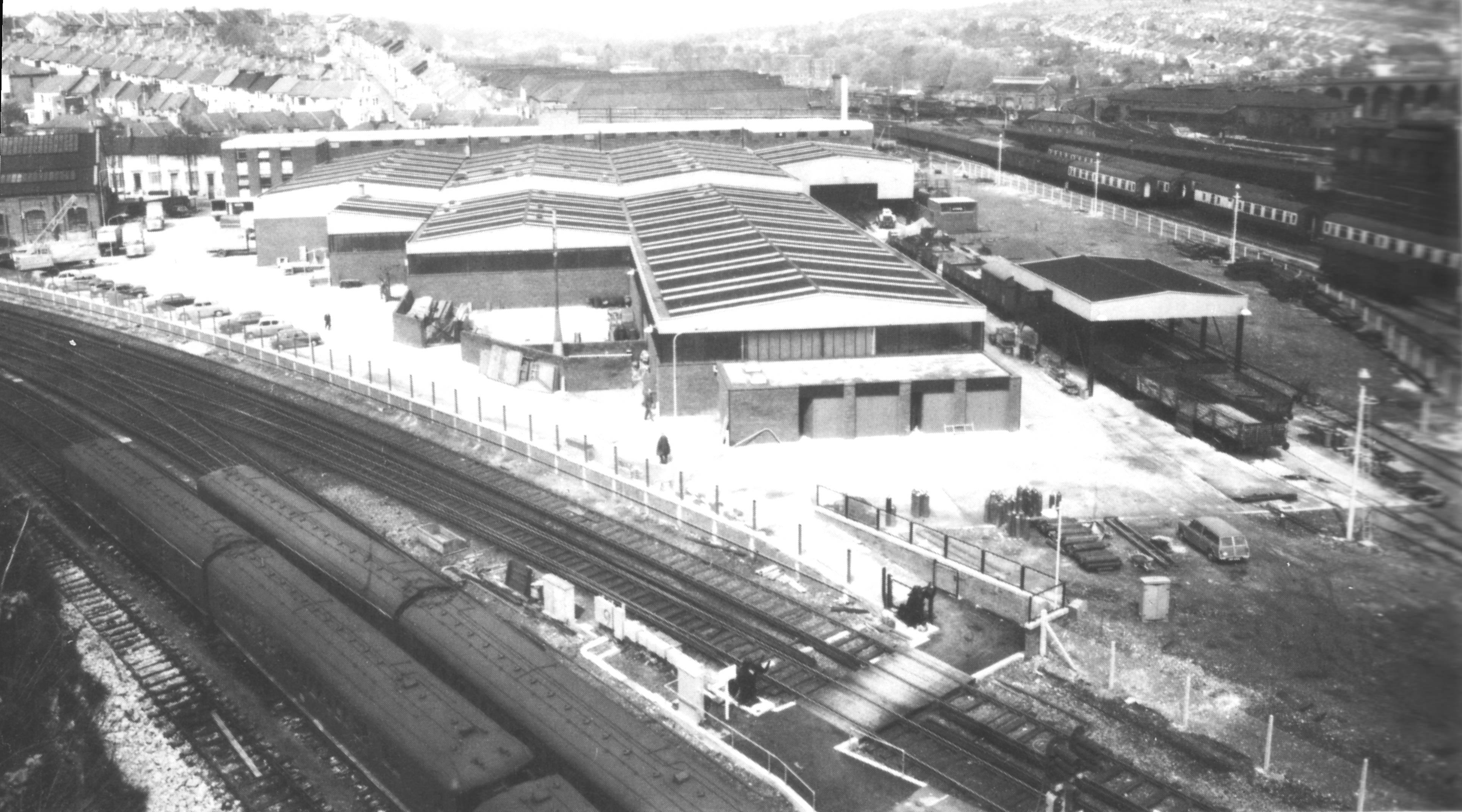
ABOVE: This picture shows The Combined Engineering Depot, which was built on the site of the old steam sheds between the West Coast Line (bottom left) and the London Main Line (top right). While it was necessary to rationalise the site, the new building looks very stark and bland compared to the buildings they replaced. Photo owned by B.K.Cooper
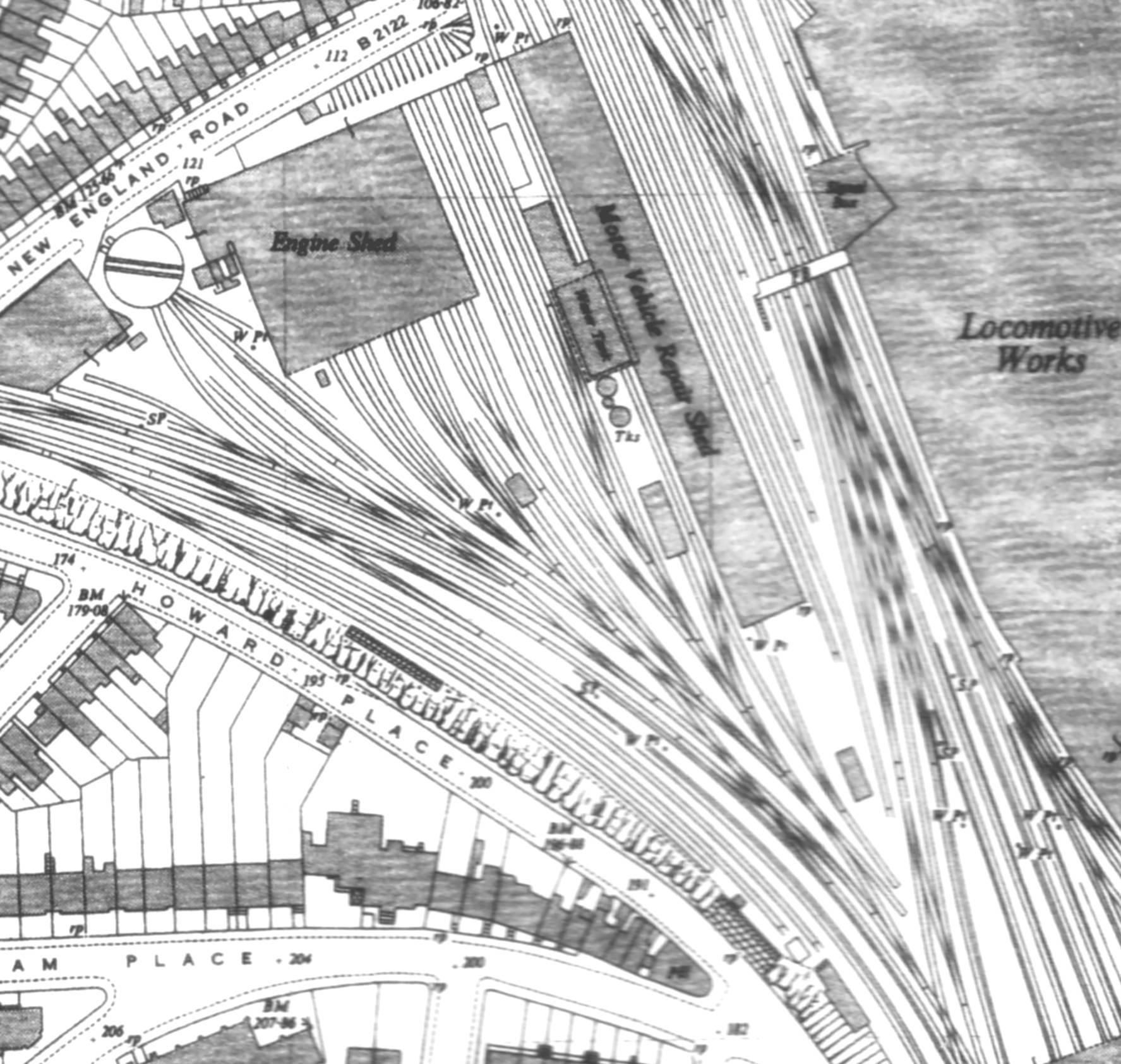
ABOVE: This map shows the position of the MPD & ‘New’ Sheds between the London Main Line (right hand-bottom to top-middle) and the West Coast Line (bottom-right to left-middle). Note the coaling area and turntable (top left) and the store building to their left. While the area was cleared in the 1960s and 1970s to make way for the Combined Engineering Depot, the store building has survived to the present day. Map owned by Ordinance Survey Publications (subsequent revisions have occured).
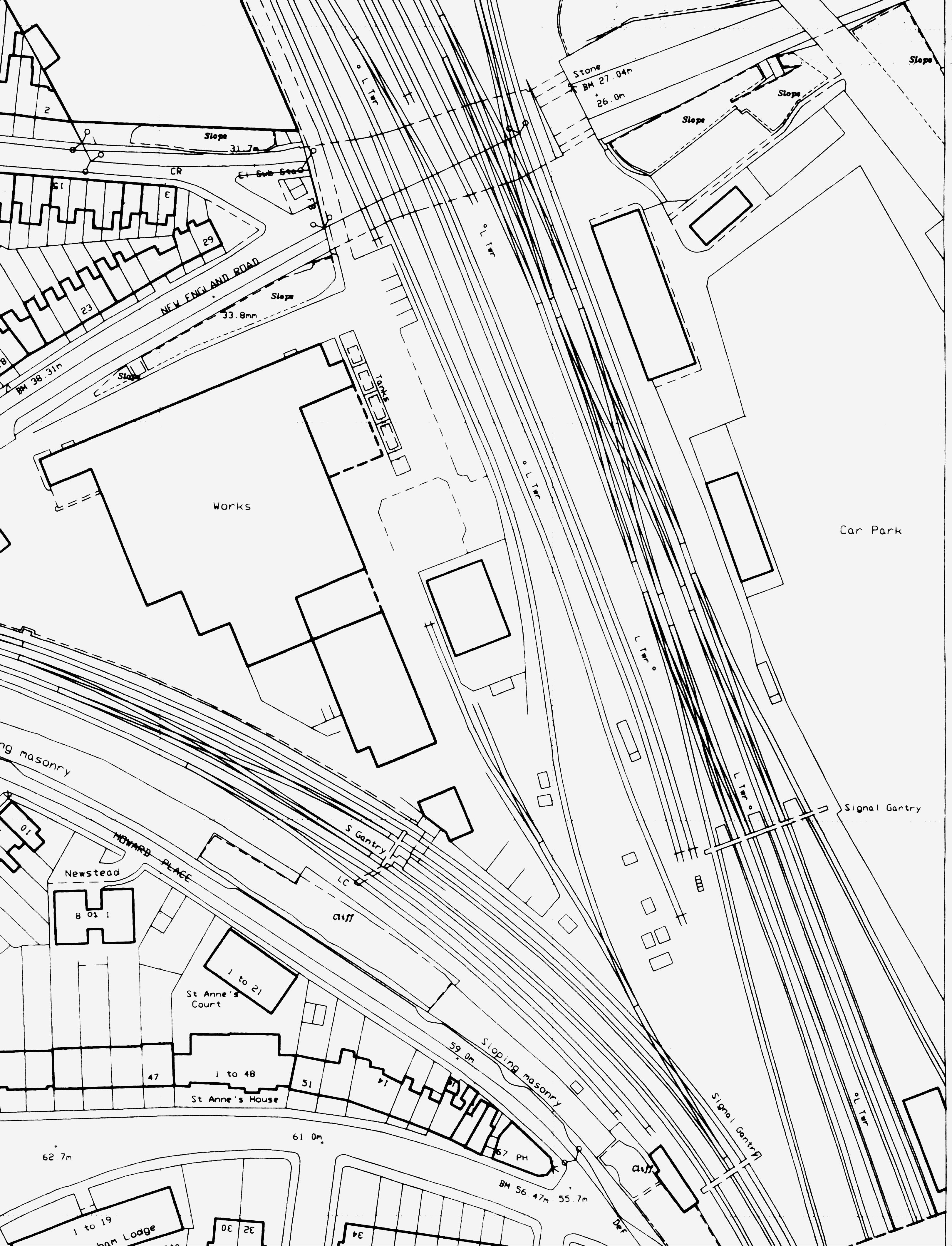
ABOVE: This map shows the Combined Engineering Works on the site of the old Steam Sheds (which were seen in the preceding map). It is interesting to note the bridge over New England Road. While the structure was widened to accept more track work, no lines actually pass over the original bridge: two buildings and the northwesterly tip of the carpark are directly in the path of any route that would have crossed the bridge. In the top right corner of the map, the bridge to the Lower Goods Yard can still be seen still intact at the present day (2013). Map owned by Ordinance Survey Publications (subsequent revisions have occured)
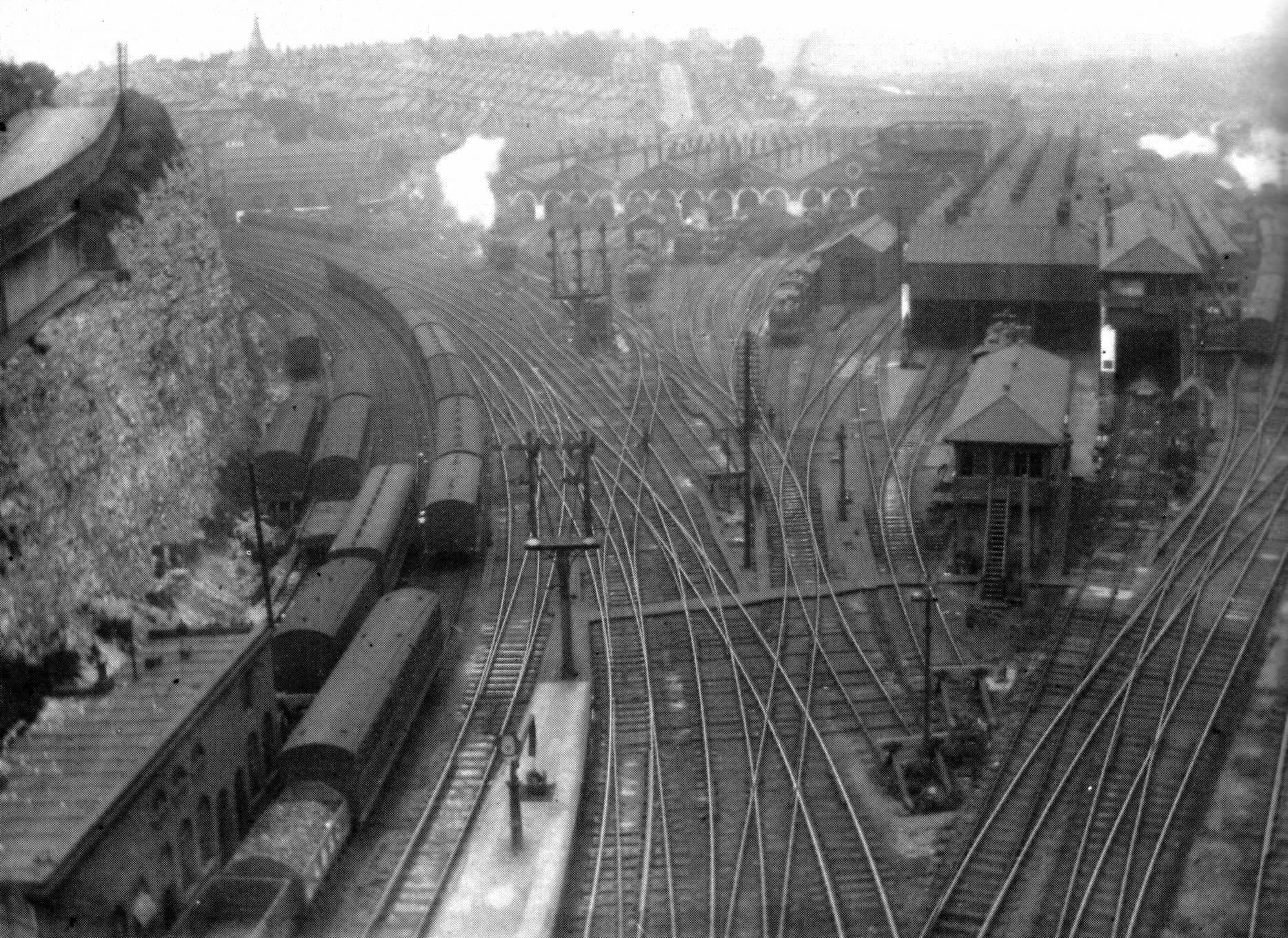
ABOVE: A birds-eye view from the top of the station roof showing the end of Platforms 1 & 2, the MPD and New Shed, West and South Signal Boxes. The West Coast Line is on the left. This picture was taken in 1924; the signal boxes were closed 9 years later. Photo is owned by Ian Allen Publishing.
It has been mentioned before that the Brighton Line drew its motive power from a pool of locomotives formed from the grouping of 2 other Railway Companies. In the early days they were maintained and repairs at New Cross in South London. Conditions there were congested, and both the LBSCR and the SER relieved the pressure by building repair shops of their own.
By the time the pooled locomotives were
distributed to the individual companies in 1846, Brighton already had
several engineering disciplines situated adjacent to the station which
undertook repairs to locos and stationary engines, also various metalwork. Carriage
and wagon work was dispersed among several places on the system, including Brighton, where the
shops were on the opposite side of the line to the other engineering
establishment, which was on the eastern side and formed the nucleus of the
Brighton Works.
Locomotive building did not begin there until the early 1850’s. The print below shows the workshops and a chimney on the east of the line as it approaches the terminus.
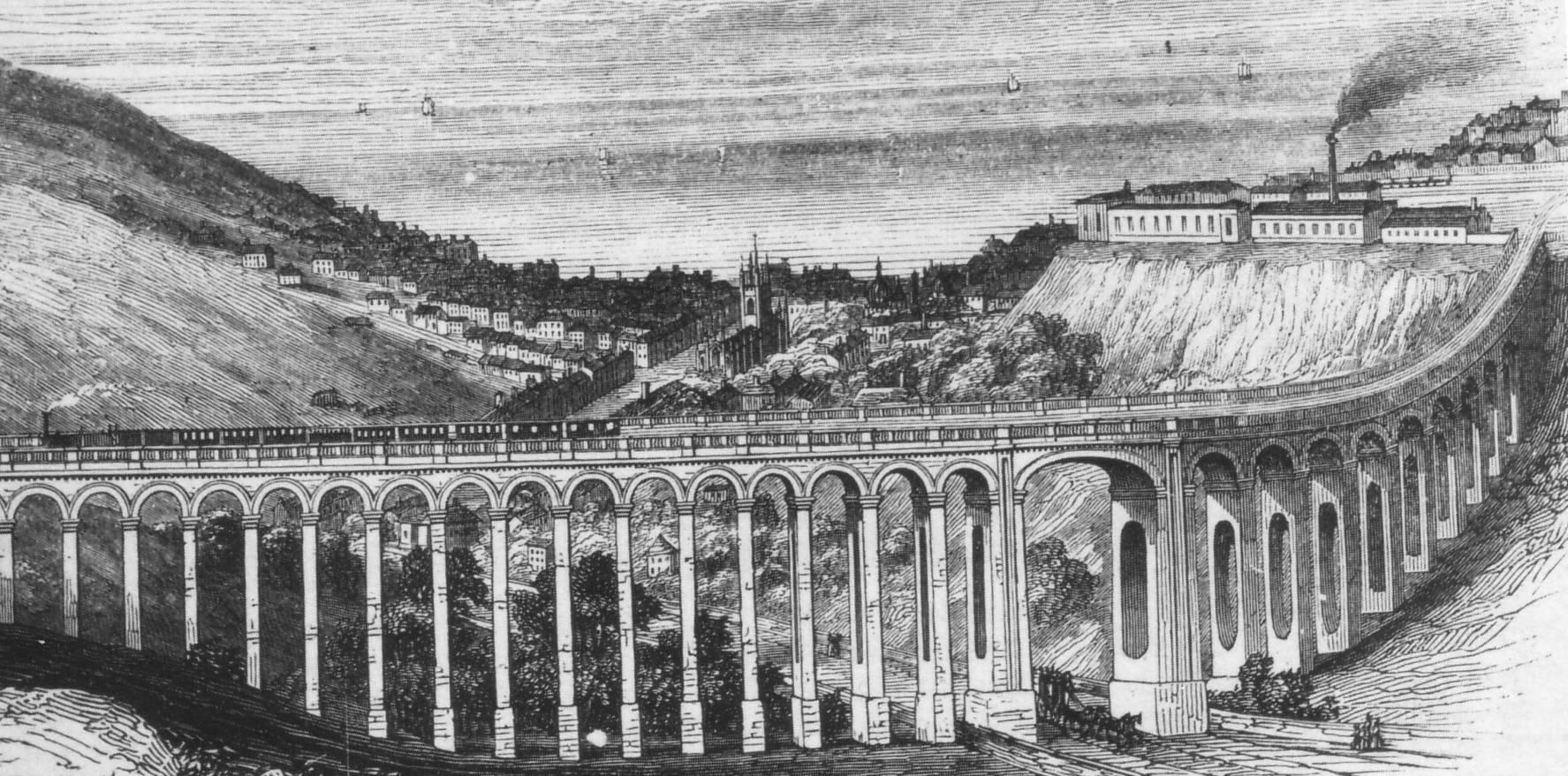
ABOVE: This view of the viaduct across London Road shows the original Works Buildings at the top right of the print, dating from around 1846. Image owned by Brighton History Resource Centre.
With the coming of the railway, the population of Brighton increased dramatically and also acquired an industrial element. From 1831 to 1841 there were only 437 new houses built in the town (the previous decade had seen around 50). Between 1841 and 1853 the number swelled to 2806. Where once there had been only half a dozen straggling streets on the slopes below the station, there were soon at least 50. These were closely lined with houses and thickly inhabited by a thriving and industrious population, a large proportion of whom derived their employment from the railway.
It is easy to forget that prior to the
arrival of the railways, Brighton’s main employment had been mainly in fishing or
agricultural. To meet the needs of industrial workers, a Mechanics Institute
was set up on
At first the housing for the ‘thriving and industrious population' was far from satisfactory. There were problems with ventilation and drainage in the thickly clustered dwellings, and in the same year that the Mechanics’ Institute was founded, a certain Dr. Kebble wrote that ‘noone accustomed to the fresh air can walk through the streets of Industrial Brighton without being most thoroughly nauseated by the smells’. These problems receded from around 1870 onwards with improvements in water supplies and sewage disposal, along with demolition of many of the old buildings that had precipitated the cause.
The Brighton Works, as a centre of locomotive building, were the creation of Mr. John Chester Craven, a figure who seems to have been cast in the very sternest Victorian mould. When he joined the LBSCR in 1847 as Locomotive Superintendent, he had already amassed an impressive portfolio of previous projects. It was Mr. Craven who had overseen the moving of the Eastern Counties Railway’s engineering works from Romford to Stratford.
He was charged with the task of expanding Brighton’s repair shops on their somewhat restricted site, adjacent to Brighton Passenger Station. It is worth noting here that there were plans drawn up to do the same as the Eastern Counties had done, and relocate the Works facilities to Horley (a nondescript and now insignificant station on the route to London). Fortunately for the town and its thousands of workers, these never came to fruition and the decision was taken to augment what already existed at Brighton.
The Brighton Works were on the East Side of the main
line, immediately North of the passenger station and overlooking the valley
through which
The power for the majority of the machinery in the original Works was provided, at first, by an old Sharp single steam engine, No.25. This engine was stripped of its driving wheels and adapted for use with the belt driven line shafting used to power The Works. It was later replaced by a vertical steam engine.
The Works had its own 170ft well for water supply, from which water was pumped to an overhead tank by a compound beam engine (the machine used was originally from the pumps on the London & Croydon Railway’s atmospheric system). There was no foundry on the site at first and all castings were brought in from outside.
In 1852, The Works produced their first home-built locos – two small, single driver well tanks. These were to be the first in a great variety of engines built under the Craven regime. Each class of locomotive was produced in a limited quantity and each batch produced needed their own spare parts. This lead to chronic congestion in The Works. When Mr. William Stroudley took over from Mr. Craven in 1870, the LBSCR is said to have 72 different classes of locomotive in operation, presumably including locos brought in from outside companies prior to the LBSCR grouping, which had been modified in various ways to suit Mr. Craven’s ideas and requirements.
BELOW: The three pictures shown here are roughly sequential and run north to south along the length of the original Works. The view above is taken from Terminus Road in 1871and shows the Montpelier Box (top left) and the dainty little platform alongside the works building. Ticket inspectors used this on down trains. This was done just short of many termini at the time and much to the annoyance of passengers, particularly as the benefits of corridors were not available. Images owned by The Madgewick Collection / Ian Allen Publishing.
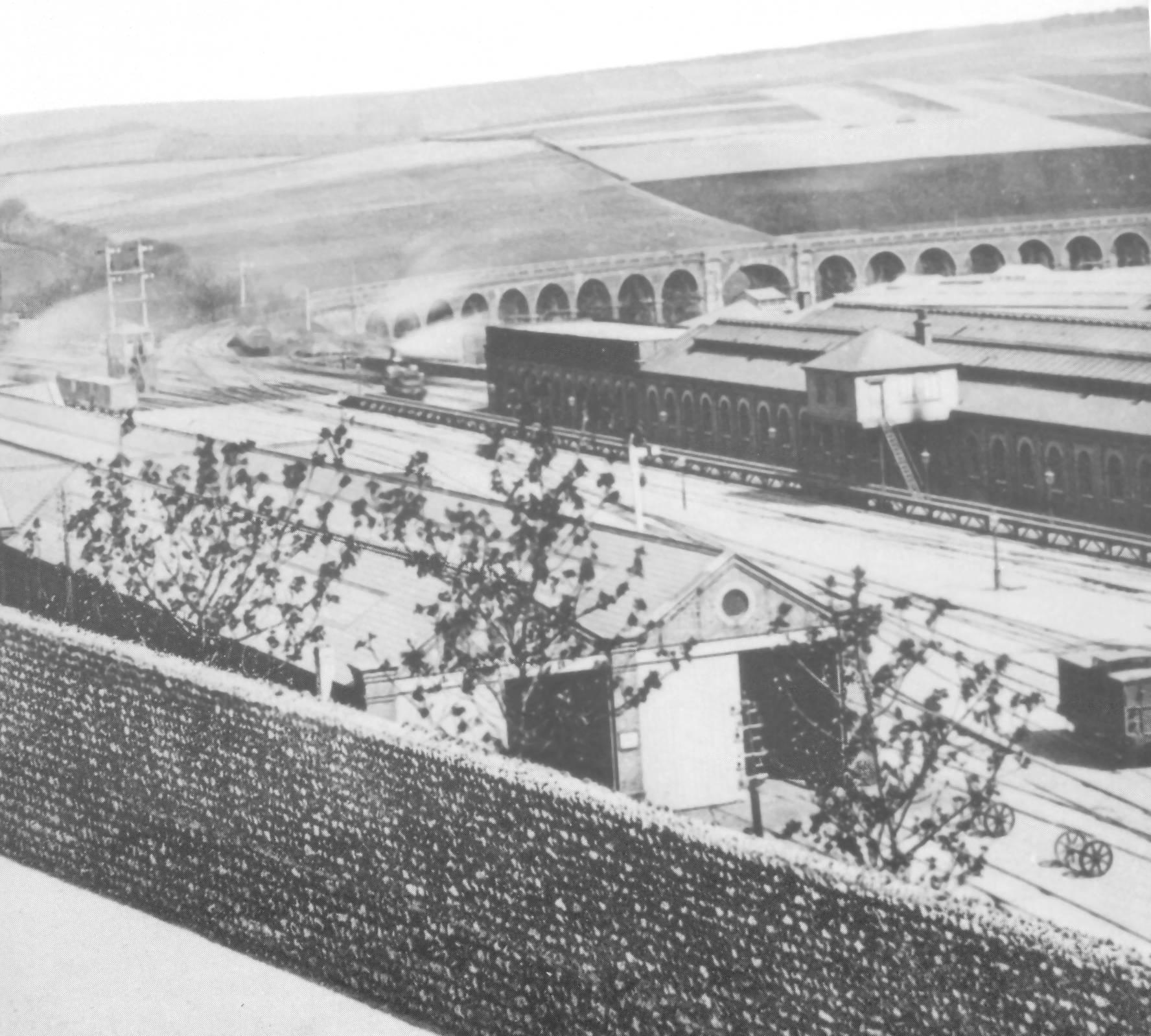
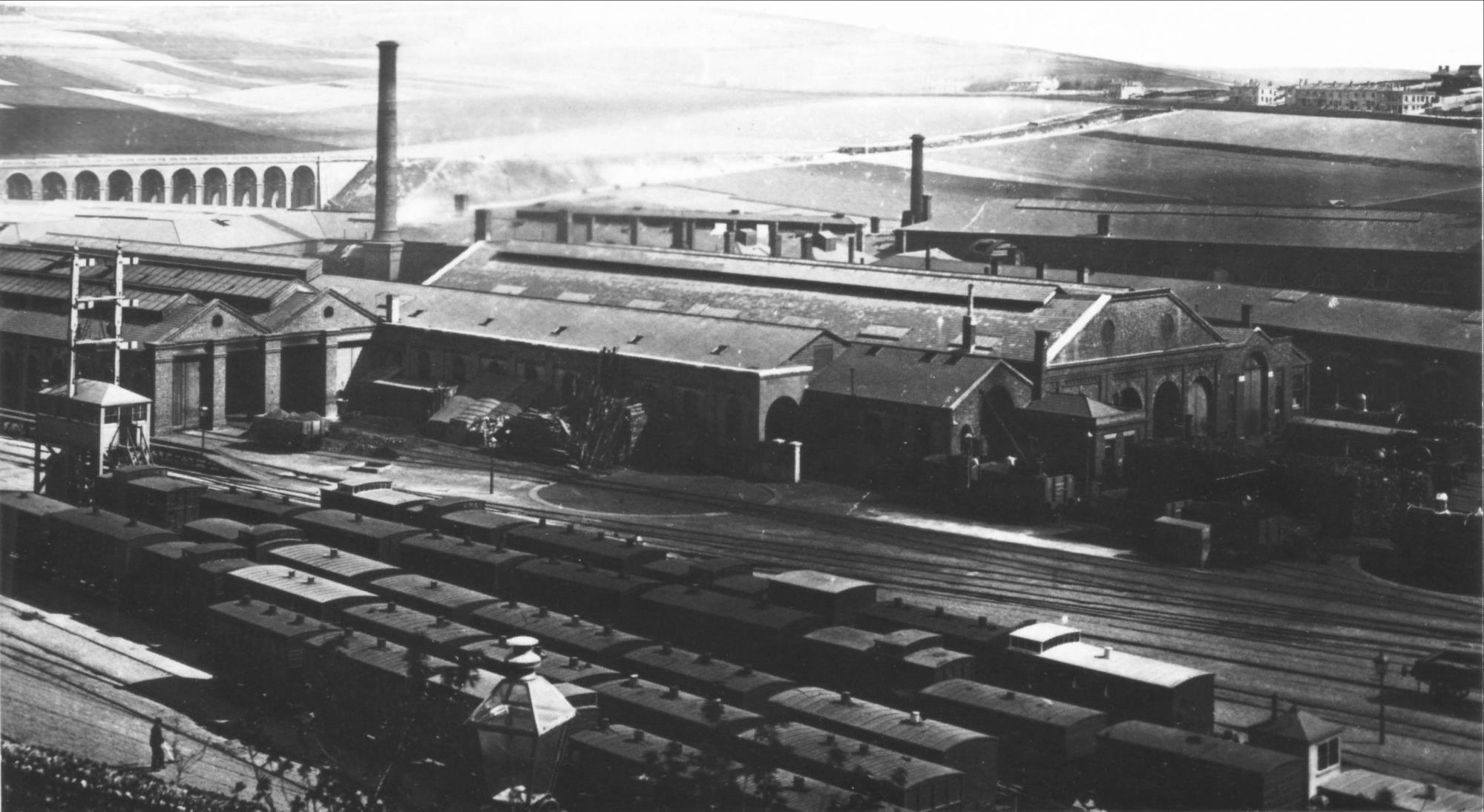

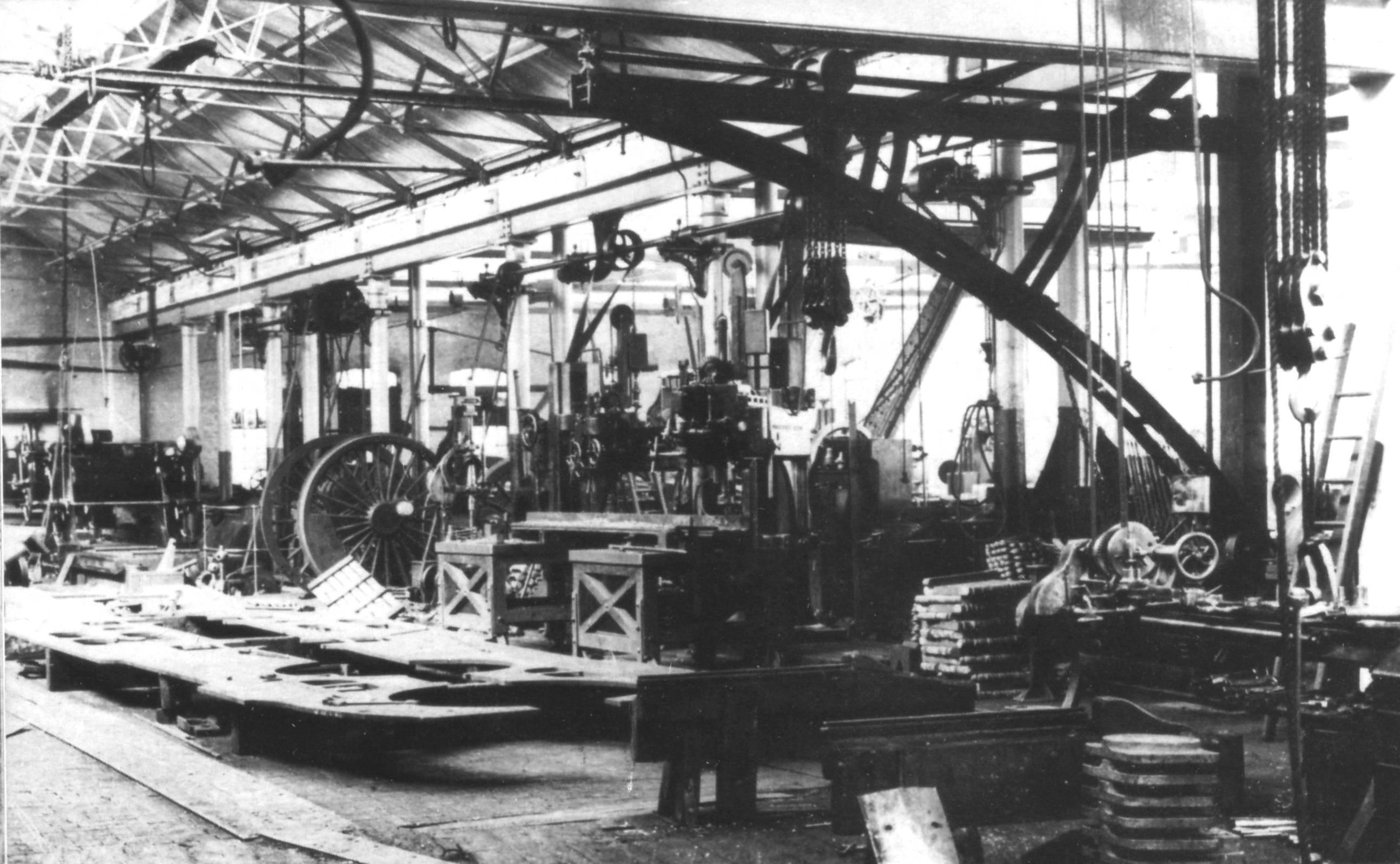
ABOVE: This photo shows the interior of the Wheel Shop. Note that belts drive the machinery from the overhead line shaft. A stationary engine drove these on site. Image owned by The Madgewick Collection / Ian Allen Publishing.
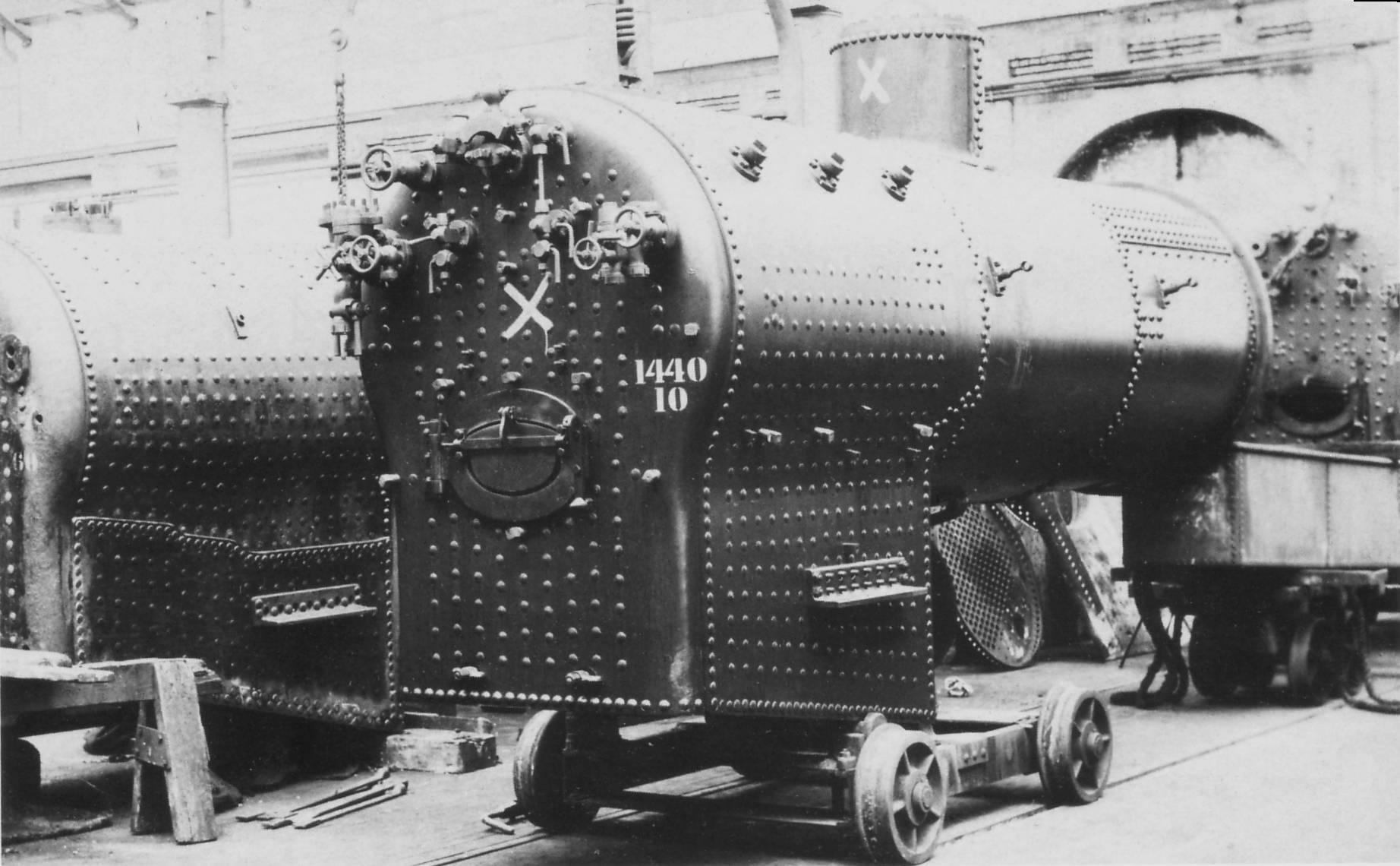
ABOVE: This view shows two boilers fresh from production in the Boiler Shop. This is one area of production that Mr. Stroudley had strong views on and forbid the use of machined rivets in boiler production. He insisted that all boilers be hand assembled and was a firm invigilator when it came to precision work and attention to detail. Image owned by The Madgewick Collection / Ian Allen Publishing.
Further machinery was acquired in 1860 & 1861, and in the latter year a new carriage shop was built, but still detached from the main works. In the early days of the works the locomotive and carriage sidings were on the same site. There was a great deal of shunting in the yard and these operations often encroached on the main lines, often delaying departures. Looking for more space on the site, Craven decided to remove a large chalk hill which had been formed from spoil when the plateau for the station and main line were excavated.
Originally, Brighton Council objected to the proposals on the grounds that the view of an artificial chalk mound would be far preferable to the “mundane sight of locomotives and carriages”. This caused Mr. Craven to resurrect the idea of moving the works to Horley. Realising that this would result in a massive migration of the town’s main employer and workforce, the council relented. The chalk mound was dispersed to various sites on the rail network (a large amount was used at Shoreham on expansion of Kingston Wharf, also in the creation of what would become the lower goods yard). The removal was a long process, starting in 1854 and not being completed until the early 1860’s. The benefit came too late to be felt by Mr. Craven (who retired in 1869), but instead by his successor, Mr. William Stroudley.
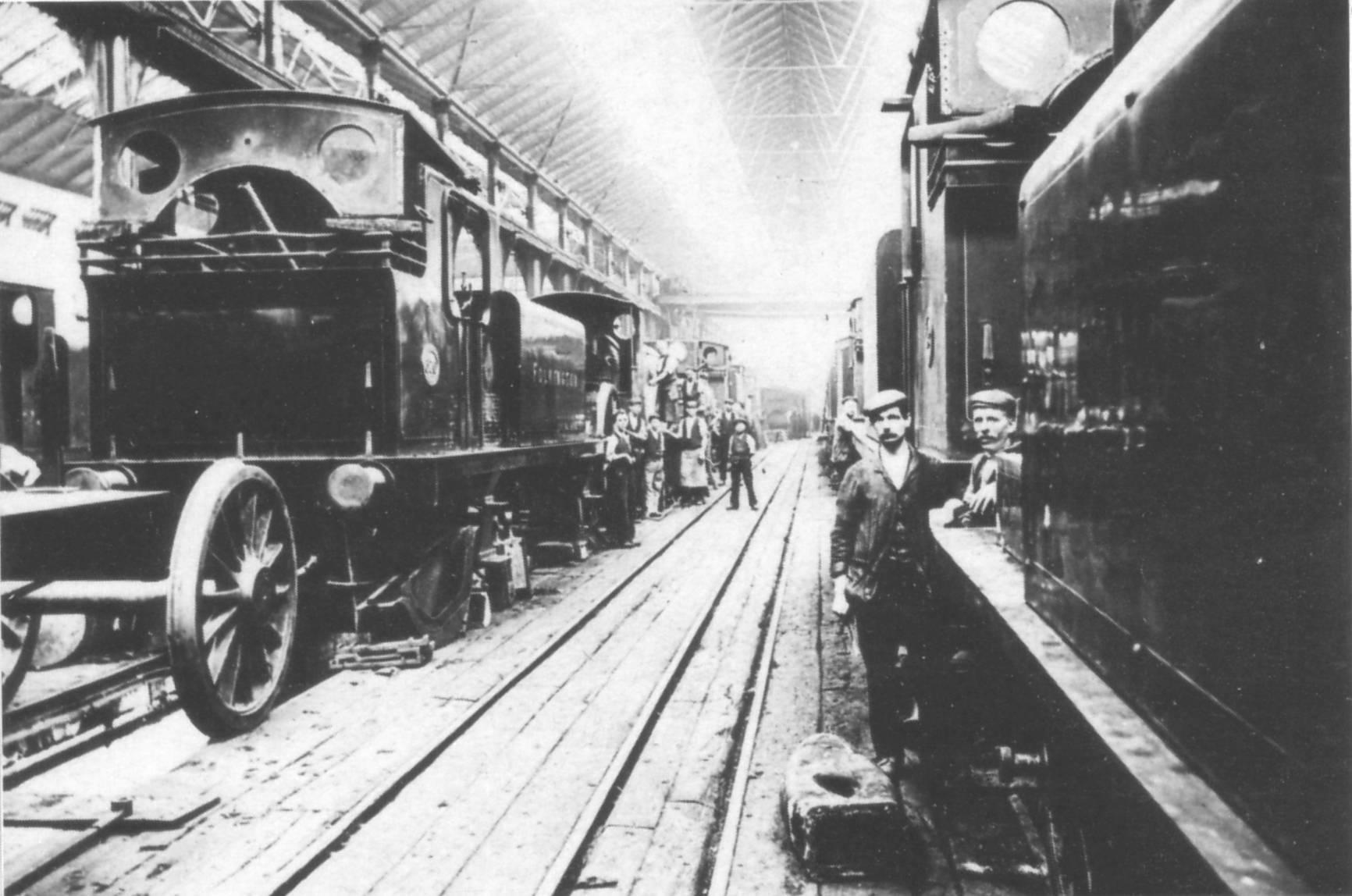
ABOVE: This photo shows a view down the length of the vast erecting shop. Image owned by Madgewick/IAL
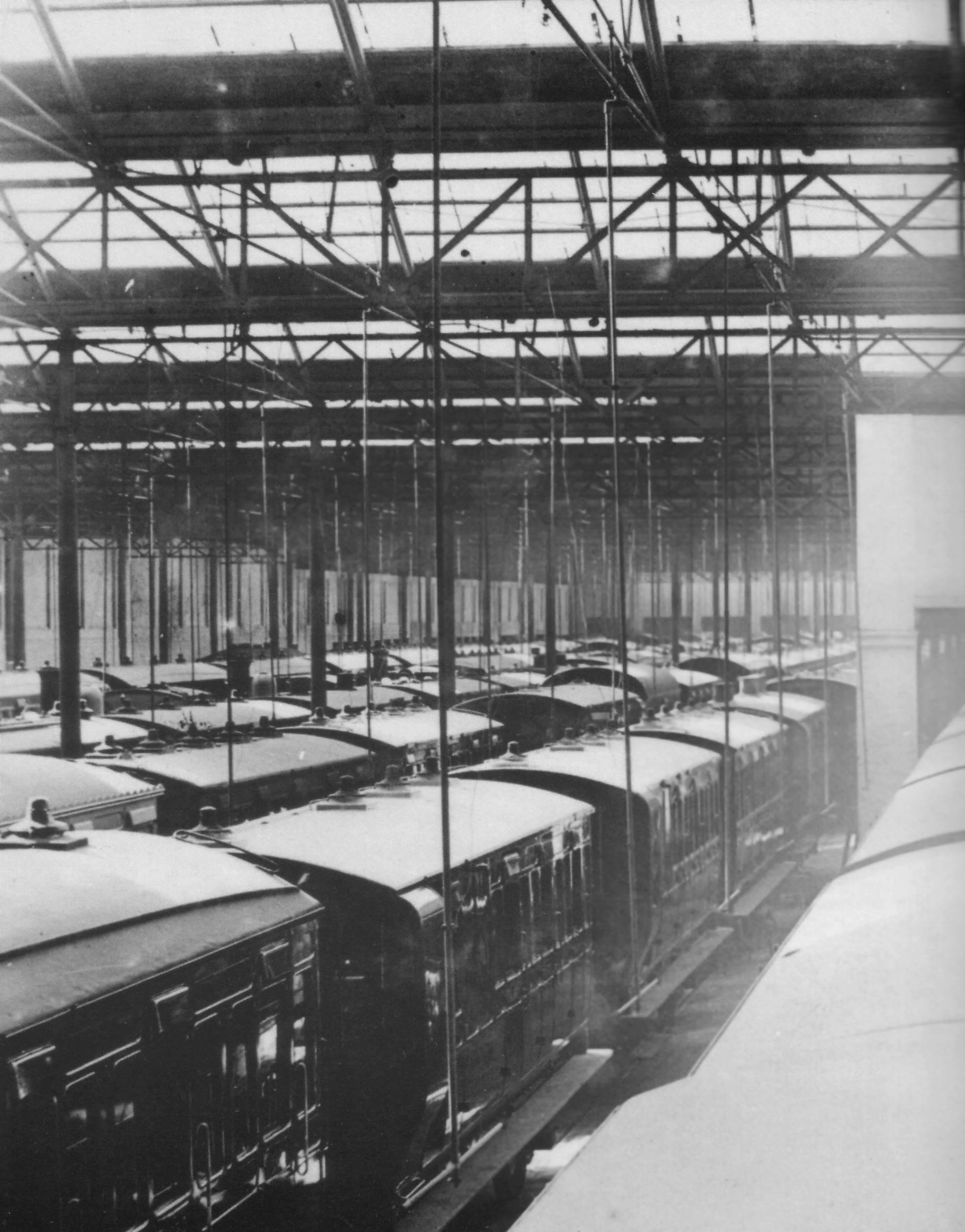
ABOVE: The forest of gas pipes hanging from the roof of the Paint Shop feed burners just below carriage roof level, providing light and also warm updraughts to help the paint dry. A variety of items were painted here including goods stock, horse drawn vehicles and locos. Photo owned by Chris Horlock Collection.
It was Mr. Stroudley who was able to move the locomotive depot to the newly cleared site, where it remained until the end of the steam era. On his appointment, he applied himself to reducing the variety of classes of loco and their associated spare parts that had been amassed by his pre-decessor. Mr. Stroudley’s policy was to develop 6 standard classes with interchangeable components, so that a relatively small stock of spares would suffice to meet requirements on demand and minimise downtime for locomotives in The Works.
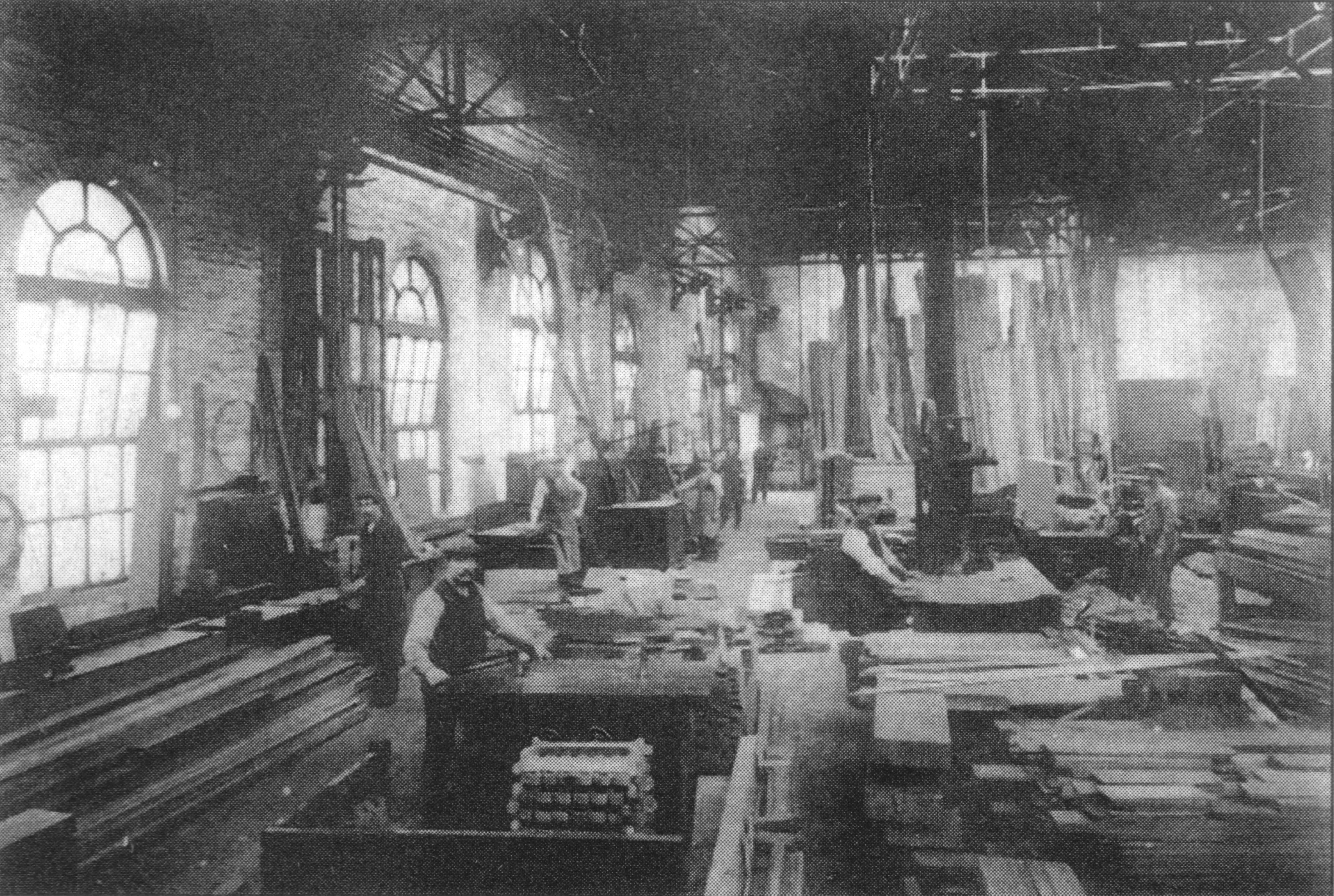
ABOVE: This photo shows the interior of the Sawmill and Carpentry Shop.
Mr. Stroudley’s clarity of thought also manifested itself through his fastidious attention to detail. In The Works, he insisted on precision in machining, and he saw that it was achieved by encouraging craftsmanship in individuals and also in gangs of men engaged in specific tasks. This policy extended even to the painting of names on engines, which was in the hands of one man from Stroudley’s era up until hand painting was discontinued.
Mr. Stroudley’s attention to “doing the job right” also came out in his views regarding boiler making. He believed that machine riveting caused stress fractures when the rivets were squeezed into the holes in the plates. Instead, his method of boiler making was to put the plates in a frame, and drill the rivet holes while the plates were together so that the holes would be dead true. The plates were then taken from the frame and assembled by hand.
As soon as he was appointed, Mr. Stroudley began to make changes in the organisation of The Works. He had carriage and wagon building transferred from the west side of the line to the main Works site on the east, and the loco depot was moved to the west, taking advantage of the additional space made available through the removal of the chalk hill. Mr. Craven’s original erecting shop was converted into a smithy and a new one was built, along with a foundry and a shop producing Westinghouse brake components. To compensate for these extra activities on the main site, the paint shop was moved to the West Side of the line and a new coppersmith’s shop was added in 1881.
Apart from the impact he made on the quality of work and reorganisation he bought to The Works, Mr. Stroudley will be remembered for having bought classical order and harmony to the Gothic wilderness of the old Brighton Works as Mr. Craven had left them.
When Mr. Stroudley died in 1889 he was succeeded by Mr. R. J. Billinton. The LBSCR rolling stock was increasing rapidly and during Mr. Billinton’s regime, swelled from 410 in 1890 to 535 by 1902. Mr. Billington continued to uphold Mr. Stroudley’s standardisation and spares policy, and also began the practice of storing spare boilers. This led to the inevitable expansion of the works to provide more space for boiler manufacture. It was Mr. Billinton whose expansion plans most affected the look of The Works and gave the site the distinctive and immensely impressive look to its eastern side.
As the site of The Works was packed full right up to the site boundaries, an ingenious method of making space had to be found. Mr. Billinton’s solution was simple but brutally over-engineered. He built an extension of the works out, over the goods line on the eastern side, supporting whole immense structure on 28 huge brick piles. The extension was 430 ft long and tapered from 41 ft to 53 ft wide. The extension housed the cylinder shop, iron store, spring shop, welding department, millwrights, coppersmiths shop and the fitting shop. It was truly enormous. In spite of this vast extension, congestion was still (and would continue to be) a major issue in The Works. In 1896, The LBSCR Locomotive Department employed 3850 staff, of whom 2200 (including drivers and firemen) were stationed at Brighton.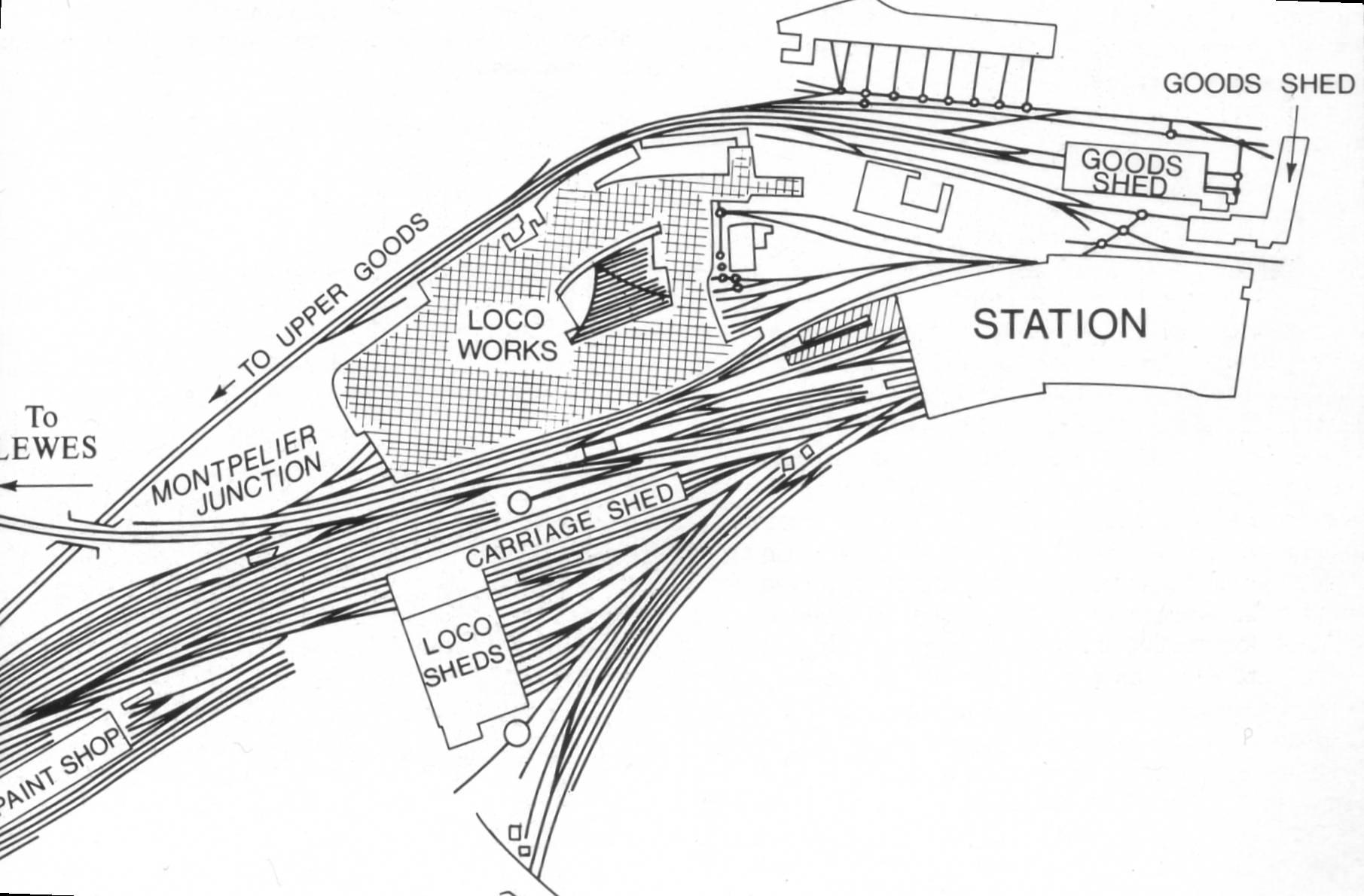
ABOVE: This diagram shows Brighton Station (centre right), Motive power depot (carriage and loco sheds in centre, at the bottom), The Works and The Lower Goods Yard (described in detail later). (This image has been manipulated for clarity and stretched vertically, but is otherwise to scale and illustrates the size of The Works well, the site covering some 9 acres in total). This view dates from 1875 and changed little until the end of the steam era. Image owned by B.K.Cooper
In 1896 Brighton Works was building 12 locomotives a year and there were between 40 and 50 going through the various shops for repair and maintenance. By this time, electric power was being used for some purposes and the works had its own electricity generating plant. This consisted of 3 large electrical dynamos and three beautiful stationary steam engines to drive them. A 4th engine drove the plant in the nearby sawmill.
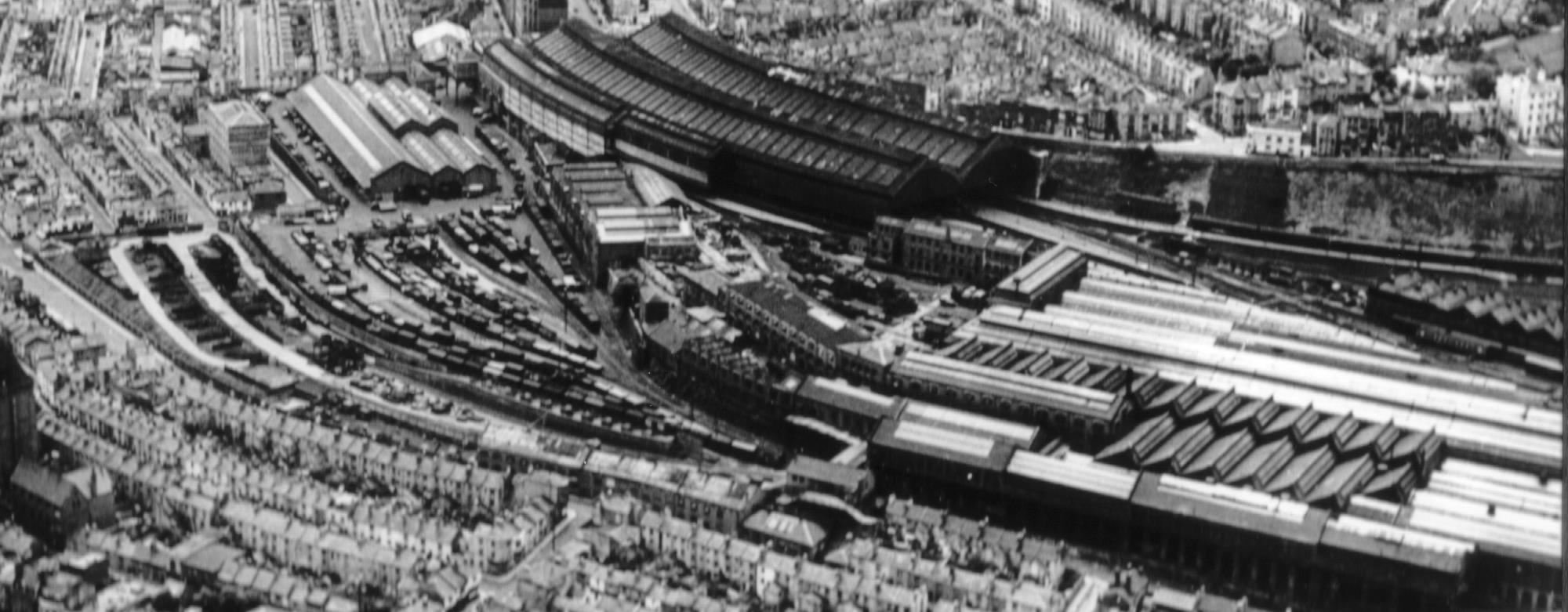
ABOVE: This aerial view of Brighton Station, The Works & Goods Yards illustrates just how vast the complex was. The curve of the station canopy can be seen top centre & The Works can be seen bottom right. The Goods yard & coal yard are both far left. Note the pay office & walkway over the Lower Goods Line, (bottom centre of the photo). This was the main pedestrian entrance for The Works & was still standing until as recently as 2005, albeit derelict & fenced off. Sadly, in recent years, only the station & the adjacent offices have survived serious redevelopment; the Lower Goods Yard is now the New England Quarter development, the works building nearest the Main Line Tracks is now a multi-storey car park & those towards the bottom of the photo are set to become a Sainsburys superstore, restaurants, hotels, offices and mixed housing. So far in the redevelopment, only the road names hint at the site’s Engineering past. Image from Author’s Collection: original ownership is unknown.

ABOVE: This map shows the layout and useage of the various parts of the Loco Works as at the site's zenith. Image owned by Ian Allen Publishing.

ABOVE: This view of Brighton Works from the East taken in 1959 shows the extension built over the line to the Lower Goods yard (in the lower left foreground) built by Mr. R. J. Billinton. The Lower Goods Line crosses New England Road on an elaborate single arch bridge seen on the extreme right of the picture. Image from owner's private collection.

ABOVE: This view shows a wide shot of the whole Works building. While nothing remains of The Works in the present day, there are still hints of its existence. The majority of the brick piers which supported the extension remain, the bridge, embankment & also the retaining wall of the far end of the works foundations (immediately left of the bridge in the picture) all survive to date.
The site was cleared as a result of Rationalisation in the 60’s & early 70’s and was made into a huge carpark, with only the lower goods area remaining. In 2003 to 2005, the entire 9-acre site underwent a massive redevelopment. A network of access roads have been built round the site, a development of houses and apartments is shooting up at the southern end of the site and there are also plans for shops, offices, hotels and restaurants. Plans for a 400ft tall tower had been drawn up but it appears unlikely that it will ever become a reality due to the huge shadow it would cast across most of Brighton! It would have contained a hotel, flats of varying sizes and a Sky Garden with spectacular views across the surrounding vista. At the time of writing, the majority of the site has been redeveloped, with only the area to the immediate east and north-east of the Station building (Blocks H & J) due to be built on at the present time (July 2013).
There is a public square & garden and the area under the extension in the photo has been kept as a “Green Corridor”, a leafy pathway between the North Laine area & the busy Old Shoreham Road. One must hope that there will be an explanation of the purpose of the brick piers & of the fantastical buildings, which once proudly stood on the site.
Image owned by Ian Allen Publishing.
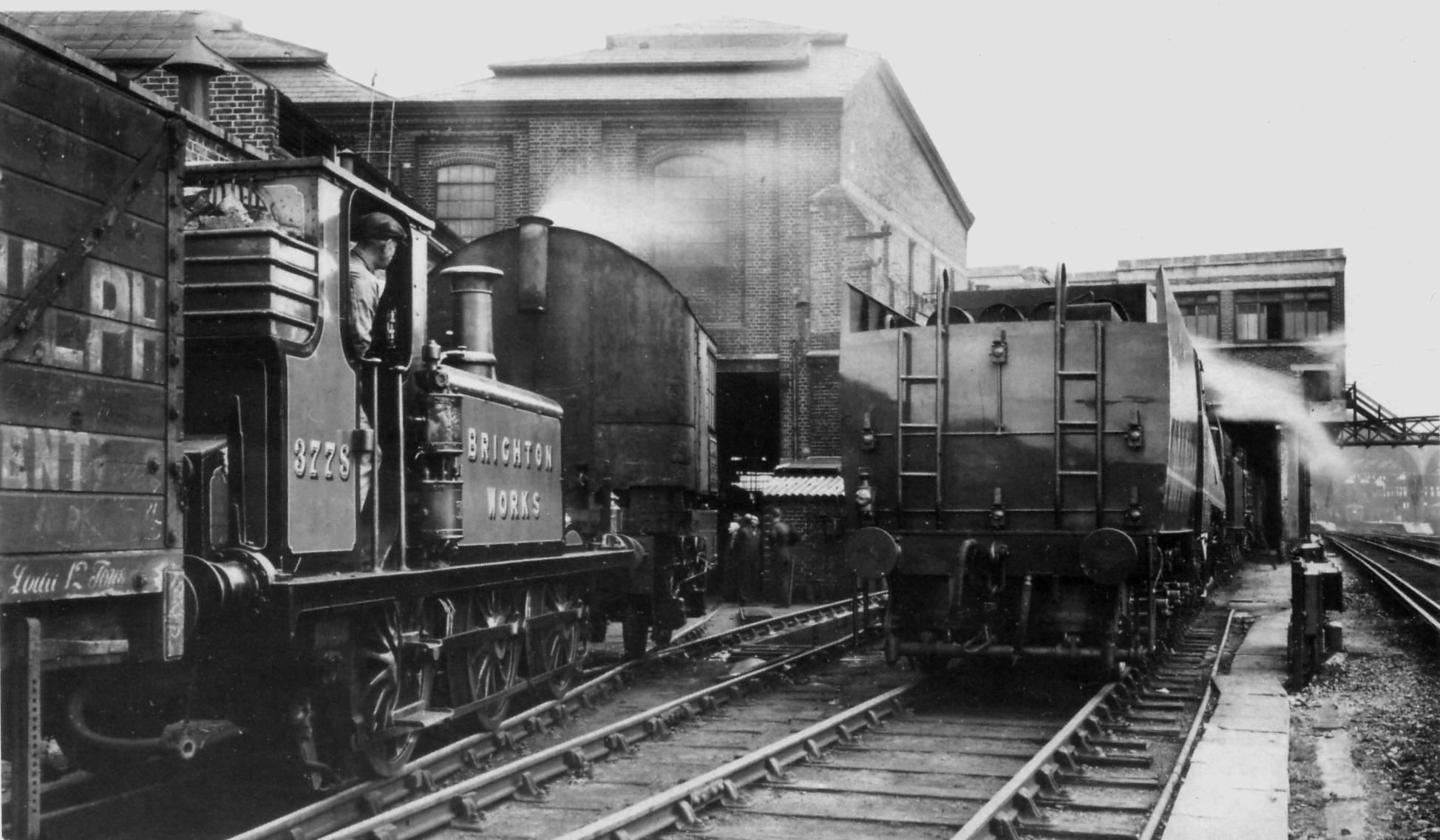
ABOVE: ‘Terrier’ No. 3778 (formerly 635) “Brighton Works” on shunting duties, about to enter the Northern end of the Erecting Shop on one of the two tracks which ran the length of the shop. Just to the left of the cab stands The Hardening Shop and the New Signal Box (built 1935) can be seen perched precariously on the northern tip of the Boiler Shop (far right). Image owned by Ian Allen Publishing.
The Erecting shop had been almost doubled in length in 1892, with two tracks running from end to end. At this time, work was still being carried out in buildings on the opposite side of the London Main Line, as had been the case in Mr. Craven’s day. This work included upholstery, cart and van repairs, minor repairs and construction of wagons and goods stock. Under Mr. Billinton’s regime, consideration was given to moving carriage and wagon work away from the Brighton Works and a survey of possible sites was commenced. Eventually a suitable site was secured at Lancing (halfway between Shoreham and Worthing, close to the current Adur flyover on the A27). Building of the new carriage works was started in 1893, but the site was not fully operational until 1912.
Mr. D. Earle Marsh replaced Mr. Billinton as superintendent in 1905. Some internal reorganisation took place at this stage with construction of carriage and wagon frames being split into 2 separate departments at different shops, pending completion of the Lancing site. When Lancing was completed, the wagon shop at Brighton Works was reassigned to the Loco Department for running repairs. This required further expansion of a site almost bursting at the seams, so a complete new storey was added to The Works building by raising the roof over The Westinghouse by 13ft.
In 1908, The Brighton Works were connected to the Brighton electricity supply and all machinery was converted to be electrically driven, and the steam-driven generating plant was sadly scrapped. However, stationary steam locos weren’t banished altogether, as a steam heating plant was installed in the paint shop in the same year.
The last Locomotive Superintendent of the
LBSCR was (R. J. Billinton’s son) Mr. L. B. Billinton, who took office in
1911. At this time, The Works were approaching their zenith as a loco building
establishment and moving into a “big engine” era. By then, the main block of
The Works site was over 600ft long and nearly 450ft at its widest point. It
narrowed down towards the Northern end, bound by
Principal areas inside the building were:
![]() The Boiler Shop (505ft long & 126ft wide for half its
length)
The Boiler Shop (505ft long & 126ft wide for half its
length)
![]() The Erecting Shop (593ft long & 98ft wide)
The Erecting Shop (593ft long & 98ft wide)
![]() The Machine Shop (207ft long & 140ft wide across 5 bays)
The Machine Shop (207ft long & 140ft wide across 5 bays)
![]() The Forge (334ft long & 54ft wide, alongside the
erecting shop and opening into The Smithy with The Wheel and Frame Shop
adjoining).
The Forge (334ft long & 54ft wide, alongside the
erecting shop and opening into The Smithy with The Wheel and Frame Shop
adjoining).
A separate group of buildings had been constructed just North of New England Road and included Offices, a Gas House and The Boiler Clothing Store. Mr. Billinton Jnr. was responsible for a fleet of 610 locomotives.

